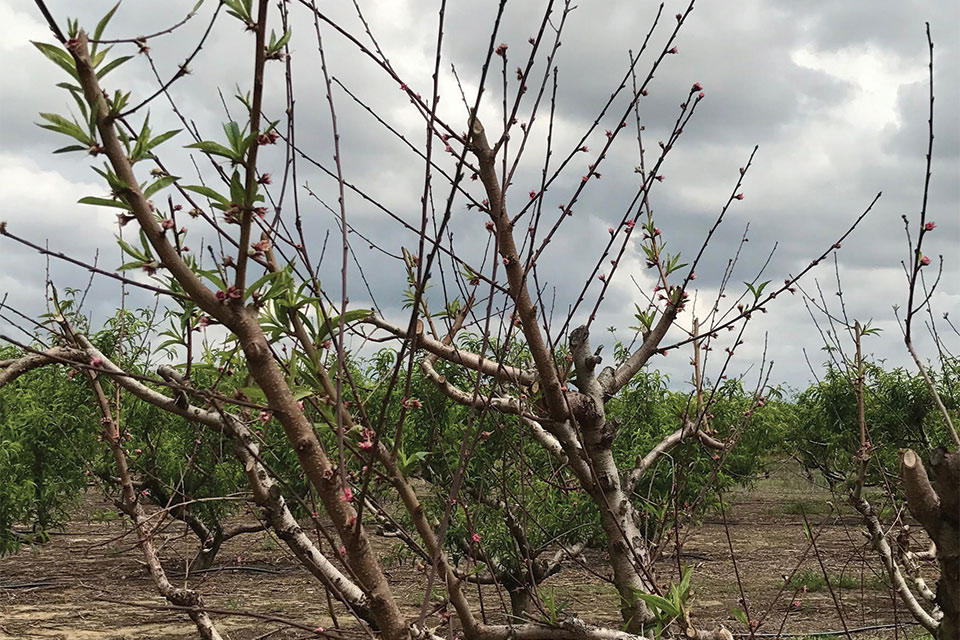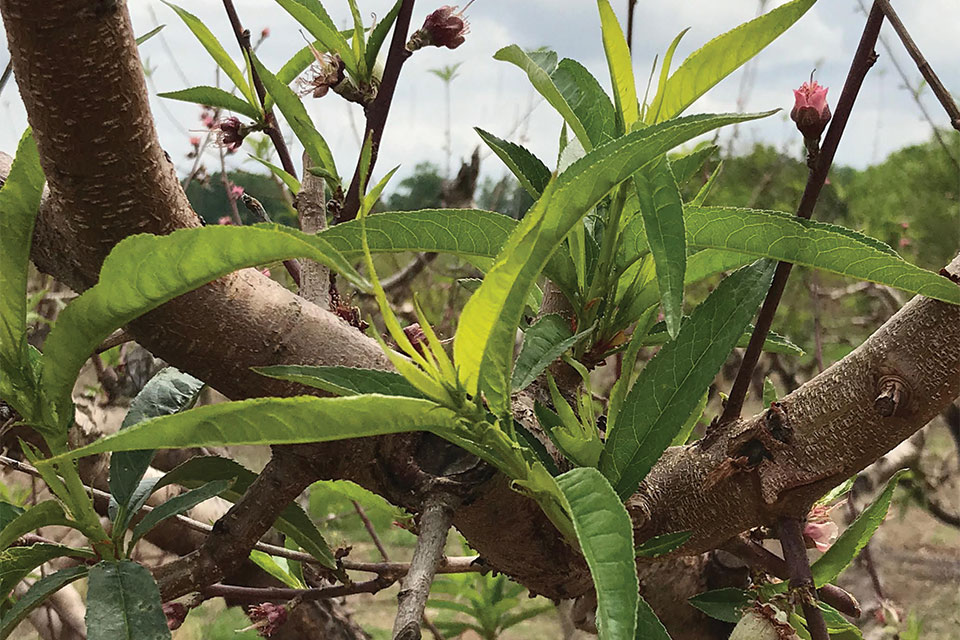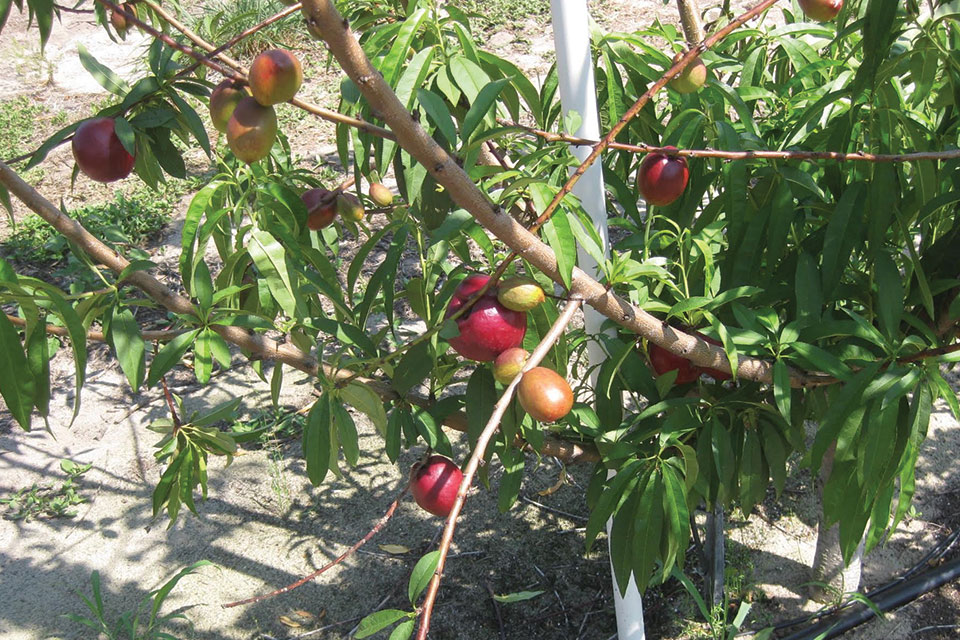How Peach Growers Can Overcome Low Chill Hours

Scaffolds shown on an insufficiently chilled peach tree. Note adequately chilled trees in background. (Photo: Gregory L. Reighard)
For Southeastern peach growers, the term “chill hours” has quickly surpassed “organic,” “alternative energy,” and “neonicotinoids” as the latest hot topic. Without the correct number of chill hours, trees either won’t bloom and produce fruit, or they will do so too late in the season. This impacts everything from the yield to the quality and the shape of the fruit.
“In general, tree fruit production becomes more difficult as the weather changes,” says Dario Chavez, Assistant Professor at the University of Georgia. “The main issue is that growers who plant fruit trees are making an upfront investment. They are hoping the trees will live for 15 to 20 years. For a long time, that was the case. Now, the trees are dying much faster.”
Over the past two years, peach growers have alternated between battling warmer winter temperatures and devastating frosts, not to mention the resulting nutrition deficiencies and pest problems. Last year, these issues came to a head, resulting in disappointing yields. It left many growers wondering: Is this the new normal?
“The general trend over the last few years is that winter temperatures are up, and that concerns me,” says Phillip M. Brannen, Ph.D., Professor and Fruit Extension Plant Pathologist at the University of Georgia.
“It’s a precarious situation because the peach trees in the ground need X number of chill hours, and it’s a problem if they don’t get them,” he says, adding that some trees were still trying to “wake up” in May 2017, two to three months later than normal. “I hope this is not a trend that will keep us out of peach production at some point.”

Basal and epicormic vegetative buds break at the base of year-old shoots due to lack of apical dominance (no auxin transport from lack of vegetative growth from shoots). (Photo: Gregory L. Reighard)
History Repeats Itself
While 2017 was particularly devastating for peach producers, Brannen says this isn’t the first time there’s been a shortage of chill hours. Georgia has experienced other unseasonably warm winters within the last 100 years. The weather eventually bounced back to familiar patterns.
History seems to be repeating itself. Brennan isn’t the only expert who thinks 2018 won’t duplicate the previous year’s problems. Many are cautiously optimistic that this year will be a good one for peach production.
To put things in perspective, Fort Valley, GA — one of the main peach-growing areas of the state — typically averages 1,100 chill hours. The city reported 642 chill hours for the Oct. 1, 2015 to Feb. 10, 2016 growing season and a measly 483 chill hours for the 2016-2017 season. This year, however, the same area has 841 chill hours with a few weeks to spare.
“The outlook for adequate chilling for peaches in the Southeast has improved significantly after a colder than normal January for a La Niña winter,” says Gregory L. Reighard, Ph.D., Professor Emeritus at Clemson University. “2018 might be a good year.”
Even if the return to relative normalcy is more than a fluke, Southeastern peach growers need to be prepared for the worst-case scenario, as well as the aftermath. In Florida, there’s been a push to breed peach varieties with lower chill hour requirements. Chavez says planting the right varieties with the right chill requirements is a delicate balance and a bit of a guessing game.
“One of the biggest issues for peach producers is determining which varieties to grow,” he explains. “It’s important to consider how a variety performs within a particular chill group and replace it if it doesn’t consistently make it.”

Blind wood (no leaves) and different sized fruit shown in this photo are due to buttoning from lack of fertilization. (Photo: Gregory L. Reighard)
Cultural Practices
The problem with many varieties with low chill requirements, Chavez says, is that the plants will meet their minimum chill requirements, only to bloom too early and then likely have to battle frost conditions. He stresses that growers can also find ways to maximize their yields, even during warmer winters.
“Pruning is the grower’s first management tool,” Chavez explains.
Because a variety’s range of chill requirements are the mean temperatures that the trees need, each bud produced may have a higher or lower ideal chill. During an unseasonably warm winter, growers select for branches with buds with the lowest chill requirements on average. This ensures the branches and buds that are likeliest to produce fruit will be properly pollinated and grow normally.
Southeastern peach growers also need to pay special attention to nutrition and crop protection, as a good fertilization regimen can limit the damage caused by a stressful season. Brannen is worried that the 2017 conditions will result in an increase of fungal organisms and canker diseases on peach trees.
“With a year like last year, where there’s low production due to low chill and freeze damage, many growers didn’t want to spray the trees for only a few peaches,” Brannen says. “There may be a lot of peaches left on the trees, and people who didn’t spray may have problems like scab as a result. This year, producers will need to have an excellent spray routine to avoid brown rot, blossom blight, and other issues.”

Scaffolds shown on an insufficiently chilled peach tree. Note adequately chilled trees in background. (Photo: Gregory L. Reighard)
Growers should also monitor the weather using in-orchard stations or the National Oceanic and Atmospheric Administration’s forecasts, use effective frost protection methods, and continually reassess the varieties that perform best in their regions. Warm winters won’t mark the end of peach production in the Southeast. There may even be some advantages to a changing climate.
“Fruit growers are very adaptable or else they would not be in business in a high-risk and high-reward agricultural enterprise,” Reighard says. “Southeastern peach growers can advance their market windows in early season with higher quality varieties that will likely require less pesticide and water use during the middle and late summer months, since earlier harvests and adequate vegetative growth would have already occurred by July for more varieties.
“Post-June peach production in the Southeast will be supplanted by more Northern growers who would likely have an earlier season in the future, too. Market windows may shift for all regions, but growers could adjust to that, as well as plant other crops to fill any new market niches that occur.”
In the meantime, experts are confident peach producers won’t have to worry about chill hours for the upcoming season. It will be the usual balancing act of resource management, nutrition, and crop protection in 2018, but things are looking up.
“I personally hope it’s going to be a banner year for peach production,” Brannen says. “We really need it.”










